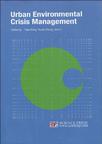城市环境危机管理
出版时间:2009-1 出版社:科学出版社 作者:宋雅杰 等著 页数:401
内容概要
The Urban Environmental Crisis Management (UECM) research initiated by Yale University and its partners from the Chinese Academy of Sciences,Peking, Tianjin (TUT), Nanjing (NUIST),Liaoning University and others in China has global significance and is in urgent demand. This book systematically surveys, analyzes, and explores better ways to enhance urban environmental crisis management. The UECM research combines with the studies on regional ecosystem stability and symbiosis (RESS) for urban regional harmony and sustainability, providing an important tool and reference for urban ecosystem management research and advancement, including theories, practices, policies, mentors,cases and comparative studies along with the UECM research progress in China and at Yale.
作者简介
Yajie Song,Research Scholar at School of Forestry& Environmental Studies, Yale University,USA, Principal Investigator of"Collaborative Urban EnvironmentalCrisis Management Research Project inChina", and Executive Director of "Yale-Tsinghua Environment and
书籍目录
IntroductionAcknowledgmentsChapter 1 Background of Urban Environmental Crisis Management Research 1.1 Origin of Urban Environmental Crisis Management 1.2 Causes of Frequent Urban Environmental Crisis 1.3 Status Quo of Urban Environmental Crisis Management Research 1.4 Major Contents of Urban Environmental Crisis Management Research 1.5 Significance of Urban Environmental Crisis Management Research ReferencesChapter 2 Overview of UECM Theories 2.1 Western Ecological Theories 2.2 Chinese Philosophy of Harmony 2.3 Comparison between Western Ecological Theories and Chinese Philosophy of Harmony ReferencesChapter 3 Theoretical Framework of the Urban Environmental Crisis Management 3.1 Urban Environmental Crisis Management 3.2 Theoretical Foundations of the Urban Environmental Crisis Management 3.3 The Supporting Systems to the Urban Environmental Crisis Management ReferencesChapter 4 Urban Environmental Crisis Management Model 4.1 Urban Environmental Crisis Management at Every Stage 4.2 Operation Mechanism of the Urban Environmental Crisis Management 4.3 Urban Environmental Crisis Management System in Developed Countries ReferencesChapter 5 Theoretical Analysis of the Urban Environmental Crisis Management 5.1 Game Analysis of the Urban Environmental Crisis Management 5.2 Comprehensive Benefit Evaluation of the Urban Environmental Crisis Management 5.3 Sustainable Development Capability of the Urban Environmental Crisis Management ReferencesChapter 6 Governmental Function in the Urban Environmental Crisis Management 6.1 Governmental Function and Public Administrations 6.2 Governmental Involvement Needed in the Urban Environment Crisis Management ReferencesChapter 7 NGO' s Functions in Urban Environmental Crisis Management 7.1 Development of NGOs in China and the Western Countries 7.2 Public Participation and NGO Involvement Needed in UECM 7.3 Function of the Public and NGOs in UECM in China 7.4 Properly Handling Relationship between NGOs and Governments ReferencesChapter 8 Related Studies of Urban Environmental Crisis Management 8.1 Urban Environmental Crisis Management- Comparative Analysis in America and Asia from a Social Perspective 8.2 Severe Snow Storms Awaken China 8.3 Eco-city Construction and Planning Principles 8.4 A Brief Analysis on Ecological Recovery of Headwaters Preserves 8.5 Risk Management and Concept of Scientific Development of China 8.6 Studies on Effects of Coastal Dykes to Reduce Losses Caused by Storm Surges 8.7 Status Quo Analysis and Strategies for Urban Ecological System in Dongying 8.8 A Study on Taxation Policy that Promotes the Development of Green Manufacturing in China ReferencesChapter 9 Urban Enviromnental Crisis Management Cases--Natural Factors 9.1 The 2005 Hurricane Katrina Caused the Disaster to New Orleans 9.2 The 1998 Yangtze Flood 9.3 The Tangshan Earthquake of 1976 9.4 Chicago Heat Wave in 1995 ReferencesChapter 10 Urban Environmental Crisis Management Cases--Unnatural Factors 10.1 The 2005 Songhua River Contamination 10.2 The Leakiness in the Chemobyl Nuclear Power Station of the Former Soviet Union 10.3 The Impacts of "9 · 11" Event on Social Surroundings in New York 10.4 SARS Evoke Crisis in Beijing, Guangzhou and other China Metropolis ReferencesChapter 11 Development and Outlook of Urban Environmental Crisis ManagementAppendix 1 The Sino-US Correlated Laws and RegulationsAppendix 2 National Environmental Emergency Response Plan(Promulgated on January 24, 2006)Appendix 3 Environmental Pollution Emergency Response Plan for the City of Shenzhen (July, 2005 )Postscript
章节摘录
插图:Over the turn of the 21st century, a series of severe crisis have occurred around theworld, such as the September llth attacks on the United States in 2001, the outbreakof SARS epidemic in 2003, the tsunami caused by the earthquake near the IndianOcean in late 2004, the Katrina hurricane in the US in 2005, the Songhua Riverpollution in China in late 2005, and the blue-green algae bloom in Wuxi of Taihuregion in China in 2007, etc.. These crisis have greatly impacted the local economicand social development. The frequently occurred crisis across China and the worldthreaten not only the regional environment but also the global environment,consequently causing the global economy and sustainable development a series offollowing problems. According to a report of the Wall Street Journal on November 9,2005, eight of the top 10 severe disasters in US occurred during the past four yearsfrom 2001 to 2005. The following figure 1.1 reveals an increasing trend of disastersthat occurred in the world between 1975 and 2007.Economy, society and natural environment make up a complete ecosystem, inwhich the natural environment will directly influence the other two components. Thusenvironmental problems become an inevitable vital issue in social managementconcerns, and crisis response is considered an important indicator in governmentalcapability evaluation. It is critical for human beings to build a better crisismanagement system and form an effective institution to handle these crisis. Newchallenges emerge in urban management in better addressing various crisis especiallyenvironmental crisis, and preventing and mitigating consequent risks and damages.China is facing rapid economic growth along with economic globalization, and itsindustrialization is at a heavy chemical-industrial stage. This state, along with itsadvancing urbanization and new rural development.
编辑推荐
《城市环境危机管理(英文版)》由科学出版社出版。
图书封面
评论、评分、阅读与下载
用户评论 (总计1条)
- 快递很快,书也很好!
